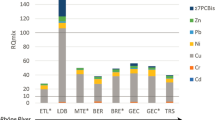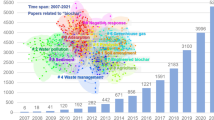Abstract
Surface sediments can accumulate contaminants that affect microorganisms and invertebrates and disturb benthic ecological functions. However, effects of contaminants on ecological functions supported by sediment communities are understudied. Here, we tested the relevance of two simple tools to assess the ecotoxicological effects of metal contamination on natural sediment communities using particulate organic matter breakdown and decomposition as a functional descriptor. To this aim, we performed a 21-day laboratory microcosm experiment to assess the individual and combined effects of Cu and As (nominal concentration of 40 mg kg−1 dw each) using the bait-lamina method (cellulose, bran flakes, and active coal in PVC strips) as well as artificial tablets (cellulose, bran flakes and active coal embedded in an agar matrix). Sediment toxicity was also evaluated using the standardized ostracod toxicity test. Both the bait-lamina and artificial tablet methods showed low effects of As on organic matter breakdown and decomposition but strong effects of Cu on this important ecological function. Both also showed that the presence of Cu and As in mixture in the sediment induced total inhibition of organic matter breakdown and decomposition. The ostracod toxicity test also showed high toxicity of Cu-spiked and Cu-plus-As-spiked sediments and low toxicity of As-spiked sediments. Besides confirming that artificial organic matter substrates are relevant and useful for assessing the functional effects of contaminants on sediment micro- and macro-organism communities, these results suggest that the proposed methods offer promising perspectives for developing tools for use in assessing functional ecotoxicology in the sediment compartment.



Similar content being viewed by others
References
Altenburger R (2011) Understanding combined effects for metal co-exposure in ecotoxicology. Met Ions Life Sci 8:1–26
Ancion PY, Lear G, Dopheide A, Lewis GD (2013) Metal concentrations in stream biofilm and sediments and their potential to explain biofilm microbial community structure. Environ Pollut 173:117–124
Andre A, Antunes SC, Gonçalves F, Pereira R (2009) Bait-lamina assay as a tool to assess the effects of metal contamination in the feeding activity of soil invertebrates within a uranium mine area. Environ Pollut 157:2368–2377
Bart S, Roudine S, Amossé J, Mougin C, Péry ARR, Pelosi C (2018) How to assess the feeding activity in ecotoxicological laboratory tests using enchytraeids? Environ Sci Pollut Res 25:33844–33848
Brosed M, Lamothe S, Chauvet E (2016) Litter breakdown for ecosystem integrity assessment also applies to streams affected by pesticides. Hydrobiologia 773:87–102
Burton GA (2013) Assessing sediment toxicity: past, present, and future. Environ. Toxicol Chem 32:1438–1440
Casabe N, Piola L, Fuchs J, Oneto ML, Pamparato L, Basack S, Gimenez R, Massaro R, Papa JC, Kesten E (2007) Ecotoxicological assessment of the effects of glyphosate and chlorpyrifos in an Argentine soya field. J Soils Sediments 7:232–239
Chapman PM (1990) The sediment quality triad approach to determining pollution-induced degradation. Sci Total Environ 97(98):815–825
Clements (1999) Metal tolerance and predator-prey interactions in benthic macroinvertebrate stream communities. Ecol Appl 9:1073–1084
Dabrin A, Durand CL, Garric J, Geffard O, Ferrari BJD, Coquery M (2012) Coupling geochemical and biological approaches to assess the availability of cadmium in freshwater sediment. Sci Total Environ 424:308–315
De Castro-Català N, Kuzmanovic M, Roig N, Sierra J, Ginebreda A, Barceló D, Pérez S, Petrovic M, Picó Y, Schuhmacher M, Muñoz I (2016) Ecotoxicity of sediments in rivers: invertebrate community, toxicity bioassays and the toxic unit approach as complementary assessment tools. Sci Total Environ 540:297–306
DREAL-REMIPP (2013) Micropolluants dans les sédiments de la région Rhône-Alpes. Données cours d’eau et plans d’eau 2006–2011. ISBN: 978-2-11-129823-1. 84 p
Farag AM, Nimick DA, Kimball BA, Church SE, Harper DD, Brumbaugh WG (2007) Concentrations of metals in water, sediment, biofilm, benthic macroinvertebrates, and fish in the Boulder River watershed, Montana, and the role of colloids in metal uptake. Arch Environ Contam Toxicol 52:397–409
Farag AM, Woodward DF, Goldstein JN, Brumbaugh W, Meyer JS (1998) Concentrations of metals associated with mining waste in sediments, biofilm, benthic macroinvertebrates, and fish from the Coeur d’Alene River Basin, Idaho. Arch Environ Contam Toxicol 34:119–127
Faupel M, Ristau K, Traunspurger W (2012) The functional response of a freshwater benthic community to cadmium pollution. Environ Pollut 162:104–109
Filzek PDB, Spurgeon DJ, Broll G, Svendsen C, Hankard PK, Parekh N, Stubberud HE, Weeks JM (2004) Metal effects on soil invertebrate feeding: measurements using the bait lamina method. Ecotoxicology 13:807–816
Gardham S, Chariton AA, Hose GC (2015) Direct and indirect effects of copper contaminated sediments on the functions of model freshwater ecosystems. Ecotoxicology 24:61–70
Ghiglione JF, Martin-Laurent F, Pesce S (2016) Microbial ecotoxicology: an emerging discipline facing contemporary environmental threats. Environ Sci Pollut Res 23:3981–3983
Griffiths BS, Römbke J, Schmelz RM, Scheffczyk A, Faber JH, Bloem J, Peres G, Cluzeau D, Chabbi A, Suhadolc M, Sousa JP, Martins da Silva P, Carvalho F, Mendes S, Morais P, Francisco R, Pereira C, Bonkowski M, Geisen S, Bardgett RD, Vries FT, Bolger T, Dirilgen T, Schmidt O, Winding A, Hendriksen NB, Johansen A, Philippot L, Plassart P, Bru D, Thomson B, Griffiths RI, Bailey MJ, Keith A, Rutgers M, Mulder C, Hannula SE, Creamer R, Stone D (2016) Selecting cost effective and policy-relevant biological indicators for European monitoring of soil biodiversity and ecosystem function. Ecol Indic 69:213–223
Höss S, Claus E, Von der Ohe PC, Brinke M, Gude H, Heininger P, Traunspurger W (2011) Nematode species at risk - a metric to assess pollution in soft sediments of freshwaters. Environ Pollut 37:940–949
INERIS (2010). Qualité chimique des sédiments fluviaux en France. Synthèse des bases de données disponibles. Rapport d’étude. N° INERIS-DRC-10-105335-04971A. 99 p
ISO 14371 (2012) Water quality—determination of freshwater sediment toxicity to Heterocypris incongruens. Crustacea, Ostracoda, 24 p
ISO 18311, 2016. Soil quality—method for testing effects of soil contaminants on the feeding activity of soil dwelling organisms—bait-lamina test, 16 p
ISO 19204, 2017. Soil quality—procedure for site-specific ecological risk assessment of soil contamination (soil quality TRIAD approach), 28 p
Jaiswal D, Pandey J (2018) Impact of heavy metal on activity of some microbial enzymes in the riverbed sediments: ecotoxicological implications in the Ganga River (India). Ecotoxicol Environ Saf 150:104–115
Jensen J, Mesman M (2006) Ecological risk assessment of contaminated land—decision support for site specific investigations. RIVM Report:711701047, 136 p
Kampfraath AA, Hunting ER, Mulder C, Breure AM, Gessner MO, Kraak MHS, Admiraal W (2012) DECOTAB: a multipurpose standard substrate to assess effects of litter quality on microbial decomposition and invertebrate consumption. Freshwater Sci 31:1156–1162
Kohušová K, Havel L, Vlasák P, Tonika J (2011) A long-term survey of heavy metals and specific organic compounds in biofilms, sediments and surface water in a heavily affected river in the Czech Republic. Environ Monit Assess 174:555–572
Kratz W (1998) The bait-lamina test. Environ Sci Pollut Res 5:94–96
Kudlak B, Wolska L, Namiesnik J (2011) Determination of EC50 toxicity data of selected heavy metals toward Heterocypris incongruens and their comparison to “direct-contact” and microbiotests. Environ Monit Assess 174:509–516
MacDonald DD, Ingersoll CG, Berger TA (2000) Development and evaluation of consensus-based sediment quality guidelines for freshwater ecosystems. Arch Environ Contam Toxicol 39:20–31
Mahamoud Ahmed A, Lyautey E, Bonnineau C, Dabrin A, Pesce S (2018) Environmental concentration of copper, alone or in mixture with arsenic, can impact river sediment microbial community structure and functions. Front Microbiol 9:1852
Niemeyer JC, Nogueira MA, Carvalho GM, Cohin-De-Pinho SJ, Outeiro US, Rodrigues GG, da Silva EM, Sousa JP (2012) Functional and structural parameters to assess the ecological status of a metal contaminated area in the tropics. Ecotoxicol Environ Saf 86:188–197
Niemeyer JC, de Santo FB, Guerra N, Ricardo Filho AM, Pech TM (2018) Do recommended doses of glyphosate-based herbicides affect soil invertebrates? Field and laboratory screening tests to risk assessment. Chemosphere 198:154–160
Pesce S, Perceval O, Bonnineau C, Casado-Martinez C, Dabrin A, Lyautey E, Naffrechoux E, Ferrari BJD (2018) Looking at biological community level to improve ecotoxicological assessment of freshwater sediments: report on a first French-Swiss workshop. Environ Sci Pollut Res 25:970–974
Piscart C, Navel S, Maazouzi C, Montuelle B, Cornut J, Mermillod-Blondin F, des Châtelliers MC, Simon L, Marmonier P (2011) Leaf litter recycling in benthic and hyporheic layers in agricultural streams with different types of land use. Sci Total Environ 409:4373–4380
Posthuma L, van Straalen NM (1993) Heavy-metal adaptation in terrestrial invertebrates: a review of occurrence, genetics, physiology and ecological consequences. Comp Biochem Physiol 106:11–38
Rabiet M, Coquery M, Carluer N, Gahou J, Gouy V (2015) Transfer of metal(loid)s in a small vineyard catchment: contribution of dissolved and particulate fractions in river for contrasted hydrological conditions. Environ Sci Pollut Res 22:19224–19239
Rossi F, Artigas J, Mallet C (2017) Structural and functional responses of leaf-associated fungal communities to chemical pollution in streams. Freshw Biol 62:1207–1219
Rossi F, Mallet C, Portelli C, Donnadieu F, Bonnemoy F, Artigas J (2019) Stimulation or inhibition: leaf microbial decomposition in streams subjected to complex chemical contamination. Sci Total Environ 648:1371–1383
Sevilla JB, Nakajima F, Kasuga I (2014) Comparison of aquatic and dietary exposure of heavy metals Cd, Cu, and Zn to benthic ostracod Heterocypris incongruens. Environ Toxicol Chem 33:1624–1630
Sutcliffe B, Chariton AA, Harford AJ, Hose GC, Greenfield P, Midgley DJ, Paulsen IT (2018) Diverse fungal lineages in subtropical ponds are altered by sediment-bound copper. Fungal Ecol 34:28–42
Sutcliffe B, Hose GC, Harford AJ, Midgley DJ, Greenfield P, Paulsen IT, Chariton AA (2019) Microbial communities are sensitive indicators for freshwater sediment copper contamination. Environ Pollut 247:1028–1038
Tlili A, Marechal M, Montuelle B, Volat B, Dorigo U, Bérard A (2011) Use of the MicroResp™ method to assess pollution-induced community tolerance to metals for lotic biofilms. Environ Pollut 159:18–24
Torokne A, Toro K (2010) Evaluation of the toxicity of river and creek sediments in Hungary with two different methods. Environ Toxicol 25:504–509
Vignati DAL, Ferrari BJD, Dominik J (2007) Laboratory-to-field extrapolation in aquatic sciences: conceptual frameworks are needed to narrow the gap between laboratory- and field-based research. Environ Sci Technol 41:1067–1073
Von Törne E (1990) Assessing feeding activities of soil living animals. I. Bait lamina tests. Pedobiologia 34:89–101
Welsch J, Songling C, Buckley HL, Lehto NJ, Jones EE, Case BS (2019) How many samples? Soil variability affects confidence in the use of common agroecosystem soil indicators. Ecol Indic 102:401–409
Widenfalk A, Svensson JM, Goedkoop W (2004) Effects of the pesticides captan, deltamethrin, isoproturon, and pirimicarb on the microbial community of a freshwater sediment. Environ Toxicol Chem 23:1920–1927
Yandell BS (1997) Practical data analysis for designed experiments (Crc Press)
Young RG, Matthaei CD, Townsend CR (2008) Organic matter breakdown and ecosystem metabolism: functional indicators for assessing river ecosystem health. J North Am Benthol Soc 27:605–625
Zoppini A, Marxsen J (2011) Importance of extracellular enzymes for biogeochemical processes in temporary river sediments during fluctuating dry-wet conditions. In: Shukla G, Varma A (eds) Soil enzymology. Springer-Verlag, Berlin, pp 103–117
Zoppini A, Ademollo N, Amalfitano S, Capri S, Casella P, Fazi S, Marxsen J, Patrolecco L (2016) Microbial responses to polycyclic aromatic hydrocarbon contamination in temporary river sediments: experimental insights. Sci Total Environ 541:1364–1371
Acknowledgments
The authors thank Bernadette Volat, Josiane Gahou, Bernard Motte and Christophe Rosy for their valuable technical support.
Funding
This work was funded by a grant from the Auvergne–Rhône-Alpes regional council (a Coopera grant for research and an Explora Pro grant for mobility awarded to Stéphane Pesce at the Ecotox Centre in Lausanne).
Author information
Authors and Affiliations
Corresponding author
Additional information
Responsible Editor: Philipp Gariguess
Publisher’s note
Springer Nature remains neutral with regard to jurisdictional claims in published maps and institutional affiliations.
Rights and permissions
About this article
Cite this article
Pesce, S., Campiche, S., Casado-Martinez, C. et al. Towards simple tools to assess functional effects of contaminants on natural microbial and invertebrate sediment communities. Environ Sci Pollut Res 27, 6680–6689 (2020). https://doi.org/10.1007/s11356-019-07331-z
Received:
Accepted:
Published:
Issue Date:
DOI: https://doi.org/10.1007/s11356-019-07331-z




